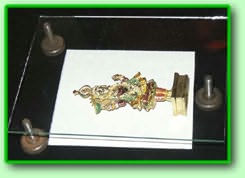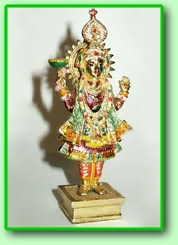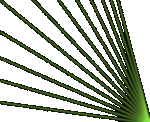|
6. Object
It
is mentioned in Lesson 1,
that we should select rigid objects made of metal,
glass, stone, etc. to be recorded with the continuous-wave
laser. If the object made of some soft material,
e.g. paper, it will be shifted by warm and air flows
during recording.
An interference pattern of the reference and object
beams also shifts and it will not be recorded on
the plate. The object on the hologram will look
black.The most important point for the same reason
is the fastening of a photoplate and object on the
base within the scheme of hologram recording. Even
when the object is rigid but it is not fixed properly
on the base, it's possible that hologram will not
be recorded.
 Let's examine a simple but
reliable and approved method - recording of a metal
object (a small statue), which is placed on the
metal plate. In such a scheme the photoplate fastening
is considerably simplified. It can be placed on
three metal supports, see the photo. It's well known
the most stable position - when the object is placed
on three supports. Therefore all the tripods have
three supporting points. Let's examine a simple but
reliable and approved method - recording of a metal
object (a small statue), which is placed on the
metal plate. In such a scheme the photoplate fastening
is considerably simplified. It can be placed on
three metal supports, see the photo. It's well known
the most stable position - when the object is placed
on three supports. Therefore all the tripods have
three supporting points.
Look at the photo. The object is placed against
the white background. The white background is more
preferable than the black one because the statue's
shadow will be visible and this factor underlines
three-dimensional effect of a holographic image.
The background should be hard.  White cardboard is not suitable
for this purpose. It can be shifted during hologram
recording. So, the background is made of white paper
sticked on the glass plate. White cardboard is not suitable
for this purpose. It can be shifted during hologram
recording. So, the background is made of white paper
sticked on the glass plate.
The object has to be checked for possible shift.
Try to shake the object lying on the table with
your finger. If you feel that the object shifts
easily, put it onto three small nuts (three supporting
points again). The nuts should not be visible on
the photoplate side. It is possible to put one nut
under the statue head and two other nuts will be
under the statue base. Try to shake the object with
finger again. If it shifts, vary position of the
nuts. It is easy to record coins, medals and other
flat hard things on three supporting points. There
is another more reliable way to fix the object on
the base. That is sticking with hard epoxy glue.
The epoxy glue includes two components, which are
mixed according to a special recipe directly before
gluing. After mixing, the glue is polymerized and
it solidifies and becomes as rigid as a stone.
Three screws with large heads are used to set a
photoplate. Their length is such, that the photoplate
is 2-3 mm higher than the object. To protect the
object against screw shadows, screws are placed
in the following way: two screws are along the edges
of the photoplate front side and one screw is in
the middle of the photoplate rear side. It will
be useful to fix the screws in the metal base or
to stick them with epoxy glue. We haven't to do
this because stability of the photoplate position
is quite enough for the present conditions of recording.
This simplest proposed variant of the photoplate
setting is possible, just to record a hologram of
small size that is not more than 9x12 cm and exposing
time should not be more than 10 sec. Photoplates
of this size have their own hardness which is enough
and they do not bend on three supporting points.
Photoplates of big size are like membranes and weak
external sources of vibration can easily cause their
resonant motion. Photoplates of big size are like
membranes and weak external sources of vibration
can easily cause their resonant motion. Special
metal frames of complicated design are demanded
in order to fasten them.
The metal plate itself where the object and the
photoplate are fixed must be also isolated against
exterior vibrations. If its weight is about 5-10
kg, the plate can be put on the tyre tube, which
is weakly pumped, or on the thick sheet of a foam-rubber.
Unfortunately, there is no universal way to protect
the plate against exterior vibrations if the hologram
is recorded under home conditions. The level of
vibration is very high on the upper floors of high-rise
building and near freeways or railroad. Conditions
are more favourable in the basement rooms or in
the silent city districts. However, the old refrigerator
or air-conditioner can spoil your holograms too.
Holograms, which are recorded at night, are better
than ones, which are recorded during day time. It
is necessary to record test-holograms in order to
achieve good results. If the object's image on the
hologram is dark or there are dark lines, it means
that the object is shifted during recording. If
there are dark lines on the photoplate, it means
that the photoplate shakes during recording.
The metal plate in our scheme is put onto the assembly
table. The basement room and short exposure (5 sec)
allow to record holograms without any special methods
to protect them against exterior vibrations. -->
|





